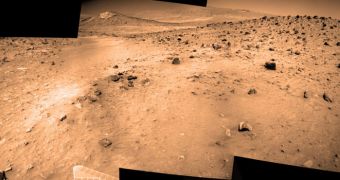Officials at the American space agency have just released the last-ever panoramic image snapped by the now-defunct rover Spirit on the surface of the Red Planet. The image shows the location of the exploration rover at the Gusev Crater, where it got stuck in sand back in 2009.
The numerous rocks and slopes that appear to surround the Mars Exploration Rover (MER) from all sides are the Columbia Hills which Spirit has been investigating for years. At the time it got stuck in sand, it was heading for a surface feature called Home Plate.
The main idea was to have the robot parked atop this small plateau. This would have ensured it had the best possible position during the fourth Martian winter it was supposed to face. However, those plans were foiled in May 2009.
At that time, while driving upwards to Home Plate, the rover's wheels pierced through a thin crust of sediments, and the machine started to sink into a patch of loose soil that experts later named Troy.
Over the next few months, mission managers at the NASA Jet Propulsion Laboratory (JPL), in Pasadena, California attempted to follow all possible scenarios for releasing Spirit from its trap.
But, despite their best efforts, winter began on Mars in March 2010, catching the exploration rover on the wrong side of the hill it was climbing. The orientation of its solar panels was unfavorable to the success of its mission, experts say.
This was coupled with the high latitude at which the robot operated. Unlike its twin Opportunity, which roves closer to the Martian equator, Spirit needed to power down during the winter, in order to save power, and to protect its electronics.
But the nefarious combination of elements it was subjected to during this winter – its fourth since landing on Mars in January 2004 – eventually drained its batteries altogether, preventing it from resurrecting again.
Yet, its mission controllers have zero regrets. Both Spirit and Opportunity were supposed to endure on Mars for only three months. The former managed to endure 4 Martian winters, which is no small feat, while the latter has already exceeded the 7-year mark on our neighboring planet.
Soon, Opportunity will be joined by the NASA Mars Science Laboratory (MSL) rover Curiosity, the first nuclear-powered exploration robot the space agency sends to the Red Planet. Together, these two will pick up from where Opportunity and Spirit left off.
Ensuring uninterrupted science data delivery from Mars until the next mission was available was perhaps the greatest achievement that Spirit was capable of, its managers say.

 14 DAY TRIAL //
14 DAY TRIAL //